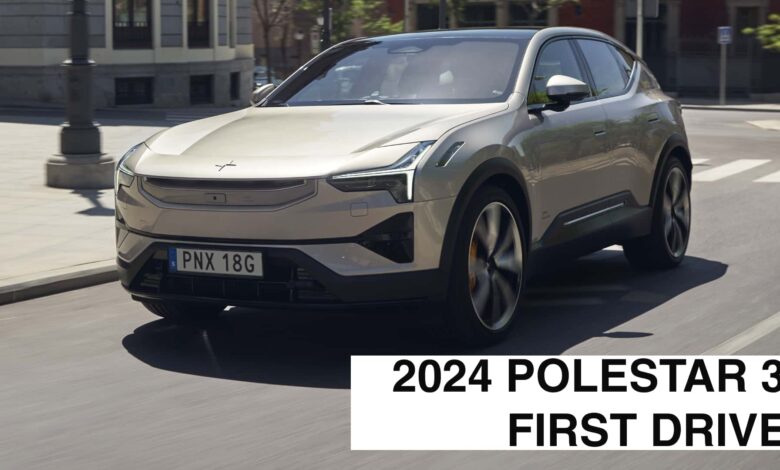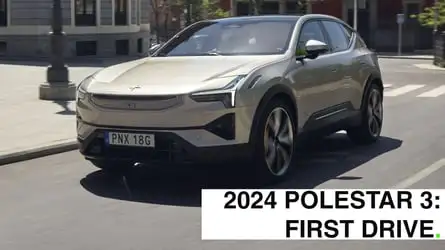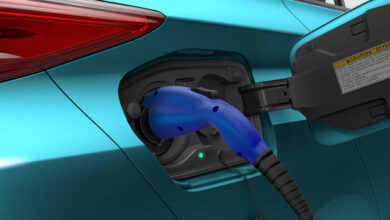The 2024 Polestar 3 Has The Potential To Be A Needed Hit

Polestar’s first crossover is pleasant, but a little pricey. Can it really take on the best from BMW, Porsche and Mercedes?

Polestar really, really, really needs a hit. Accused by many of being too similar to Volvo, while getting what feels like the short end of a rapidly charging EV market’s stick, things haven’t been great for the brand lately. Tariff woes, global sales well below prediction, and a somewhat slow rollout of more mainstream models have seen the brand’s financial outlook falter. Its current volume seller, the Polestar 2, is facing a 100% tariff within weeks—and that’s amid its own sales slowing down for being a sedan in an SUV world. Plus, Polestar’s stock is trading at less than a dollar a share and is in danger of being delisted if it keeps dropping.
The Polestar 3 needs to come in and save the day. It is a somewhat conventional midsize electric luxury crossover meant to battle in the ever-growing segment of midsize, luxury electric crossovers. The brand really hopes that this will be part of what it needs to get out of its sales malaise. With respectable power and specs to go with a handsome design, Polestar thinks this is the start of taking on more than just the Tesla Model 3, but also competitors from Porsche, Mercedes and beyond.
So, is it a hit in the making? After driving it around the outskirts of Madrid, I am not entirely convinced that it’ll sell like gangbusters, but it is a pretty big step in the right direction.
(Full Disclosure: Polestar provided travel, lodging and food for this drive event.)
What is the Polestar 3?
The Polestar 3 is a midsize-ish EV crossover aimed at cars like the BMW iX, Porsche Macan EV, Mercedes EQE SUV, and Audi Q8 E-Tron. Although it shares a common platform with the three-row Volvo EX90 (which is also larger in every dimension), the Polestar 3 aims to be the sportier, posher cousin to that car. It only has two rows, is relatively low-slung, and is designed to be the driver’s choice of the two. Likewise, Polestar wants this car to be a little more high-end than the typical Tesla Model Y or Ford Mustang Mach-E, and that’s reflected in the vehicle’s somewhat pricy starting MSRP of $73,400. Polestar also hopes that this model will be the start of a new stream of income based on sales volume and individual profitability.
Importantly, the U.S.-market Polestar 3 models will be manufactured at the Volvo plant in South Carolina alongside the Volvo EX90. For most vehicles, this isn’t all that interesting of a tidbit, but the Polestar 3’s U.S.-made distinction means it now can qualify for purchase-based IRA tax incentives.
By comparison, the Chinese-made Polestar 2 does not and may soon be subject to a 100% tariff on imported Chinese EVs, making that vehicle’s future in the US somewhat uncertain. In short, the Polestar 3 could possibly be the only car the brand sells in the near future for a short while, at least until the South Korean-made Polestar 4 is introduced later early next year. Arguably, the Polestar 4 could move the needle even more for this brand, since it starts at a more accessible $56,300.
What Are The Specs Of The Polestar 3?
Underneath, the Polestar 3 uses the same SPA2 (Scalable Product Architecture) that we’ll see used in the soon-to-be-on-sale EX90. This is explicitly a Volvo-developed platform that can handle gas and electrified powertrains, but it looks like all iterations in the future will be electric only. It’s also got some interesting tech available, like LiDAR units from Luminar and internal processing handled by Nvidia. Like a small but growing field of luxury cars adding LiDAR, that setup should empower more advanced future automated driving functions than radar, cameras and sensors can currently provide.
Still, it’s meant to be driven, and the stats reflect that. The Polestar 3 is a dual-motor SUV available with either 489 horsepower or boosted to 517 horsepower when the performance pack is purchased. Those motors are fed by a 107 kWh (net, 111 kWh gross) battery pack; allowing the car to sprint to 60 MPH in as little as 4.6 seconds. The long-range dual motor has a max range of 315 miles, but the performance pack-equipped models do take a slight range penalty, dropping that down to 279 miles. Polestar says a single motor, RWD model is in the works.
But Polestar as a whole aims for a sportier drive than Volvo. Specifically, Polestar sees itself as a direct competitor to Porsche in the Volvo and Geely family. (Where this leaves Lotus, also a Geely company these days, is unclear.) Thus, the Polestar 3 has a bevy of sport-oriented accouterments meant to invoke a better drive. Like, the rear motor on the crossover can do true power-based torque vectoring, thanks to a dual-clutch setup developed by Borg Warner. This means the car’s full output of its rear motor can be fully directed to one wheel quickly and smoothly, for tight turns and more grip. The Performance pack-equipped models also get dual-chamber active air suspension and Brembo brakes to ensure the 5,697-pound crossover remains a corner carver.
When I initially checked out the Polestar 3 during last year’s Polestar Day tech showcase event for journalists and fans, I was disappointed with the level of equipment and perceived quality for its then-$81,000 starting price. Well, it looks like Polestar’s executives got the memo because they’ve lopped $10,000 off the price. The new price is $71,000, well under all of its fully electric direct competition. A BMW iX starts at $87,250 and a Mercedes EQE SUV starts at $77,900, for example; ostensibly its closest competitor is the new Porsche Macan, which begins at $78,800. Given that Polestar isn’t a household name like those bands, coming in a little cheaper was probably a smart move.
Gallery: Polestar 3 First Drive Photos
67 Photos
Unlike other models in the Geely umbrella, namely the new Zeekr 001 and Zeekr 007, the Polestar 3 doesn’t have a fancy 800-volt electrical architecture; it makes do with a conventional 400-volt one. Still, Polestar says the crossover can handle a maximum 250 kW of power for DC fast charging, and recharge from 10-80% in as little as 30 minutes. That’s slower than cars like the new Macan EV, but still solidly respectable in the EV world. Of course, the switch to NACS is still in the works, but for now, the Polestar 3’s headed to dealerships will have the standard CCS ports.
What’s It Like To Drive?
Like most EVs in this segment and rice range, the Polestar 3 is not a light vehicle. Euro-spec models we’ve seen come in around 5,600 pounds. Similarly, although the Polestar 3 may appear to look somewhat low-slung and wagon-like to some eyes, it’s still a fairly tall crossover that leans into its crossover identity. Meaning, the Polestar 3 feels like a sporty SUV, and less like a car raised up on stilts as some of its competitors, whether they be electric or conventionally powered. Some may not like that, but I personally enjoyed it.
With that said, the Polestar is a very agile vehicle. We tested it on ice earlier this year and were extremely impressed by its controllability and maneuverability there, and it holds up equally well on the pavement, which is (hopefully) where it will mostly be driven. The model I was given to use on loan, was a Launch Edition, which came with the Plus and Performance packs already installed, meaning, I had the full-fat 517 horsepower and 671 lb-ft of torque ready to use at my disposal. Like any EV with power previously only seen in boutique supercars, a tromp down on the accelerator pedal will pin every occupant in the house to their headrests. Polestar claims 4.6 seconds to 60 mph, but at least from the seat of my pants the Polestar 3 felt quicker than that.
Despite being relatively big, wide, and heavy, the Polestar 3 didn’t feel cumbersome or like it was a chore on Madrid’s twisty back roads. The steering calibration is great, and the ratio itself is reasonably fast, without being too darty on freeways or in the city. On its air suspension, the Polestar 3’s ride is adjustable, with one of three modes: Standard, Nimble, and Firm.
In Nimble mode, the vehicles could be described as supple; it’s firm enough to imbue confidence in any sort of hard driving, but not so firm as to be completely teeth jarring elsewhere. In standard mode, the car absorbs bumps with grace, without becoming floaty or bouncy. Firm, however, is a little too, well, firm. I don’t think the penalty in ride quality is worth the slight performance edge over the Nimble mode.
What’s Good?
For starters, the Polestar 3 is a good-looking vehicle. Of course, Polestar still has yet to beat the “just a weird Volvo” allegations, and this car does not help move things forward there. But looking like Volvo isn’t necessarily a bad thing, since that brand has been on a roll within the past 10 years, making some of the best-looking vehicles in the segments they compete.
The Polestar 3 is no exception. Whereas the BMW iX and Mercedes EQE SUV are very much love-it-or-hate-it designs, the Polestar is genuinely pretty. The car has an impressive dashboard-to-axle ratio, big chunky wheels, but restrained side surfacing that makes it look purposeful, yet strong. The Polestar looks long, low, and wide for it is, but simultaneously svelte. From afar, some could be fooled into thinking that the Polestar 3 is a smaller car than it really is.
Likewise, Polestar’s user experience team has gone out of its way to craft such a strong brand identity when it comes to the text on its two interior screens. The colors are limited, the shapes are strong, and the typography is pleasant to look at. If I were still in art school, I would have gotten an A+ for a project that looked this damn good.
Overall, the UX is very stylish, and snappy, akin to a luxury tablet or smartphone. Polestar designers said they worked very hard on this part of the vehicle experience, and it shows. Designers claimed that they even designed the icons and symbols used themselves, and they’re not used on any other Volvo or Geely product.
What’s Not So Good?
With that said, although the UX is pretty and snappy, it also feels like every interaction requires navigating through one too many menus. Like, the process of changing the vehicle’s suspension settings, or turning on one-pedal driving felt like it was buried in menus. Even navigating to the vehicle’s Bluetooth audio player felt a little frustrating. Then, sometimes the layouts can be a bit repetitive, meaning it’s easy to accidentally confuse your intentions while using the thing on the move. Perhaps I’d get used to it as an owner, but after a two-hour drive, I was only slightly better at figuring things out than what I started.
Also, those Volkswagen ID.4-style window switches are terrible. There are only two on the driver’s door. The rear windows are operated by pressing “rear” and then toggling the switches again. What was the point of this? It doesn’t look good, it doesn’t really save space, and it makes everyone angry. I have no idea why Polestar went so hard for the one feature everyone hates the most about the ID.4.
Then, I have to acknowledge the elephant in the room: the interior isn’t all that nice. I will say that the seats are comfortable, but the concerns I had about the quality of the interior when I experienced it at Polestar day, are still here. The design of the interior is nice, but most of the surfaces feel harder and a little more brittle than I’d expect for this type of vehicle. At the Polestar 3’s original $83,900 starting price tag, it was unacceptable, but at $73,400, perhaps customers will find it a bit more agreeable.
How Is It As An EV?
It’s a little hard to ascertain how efficient the Polestar 3 was on our drive, since I had a very limited time with the vehicle. Also, I admit that I was driving the hell out of it – which probably isn’t an ideal way to measure consumption. But, 279 miles from 107 kWh isn’t ideal, only 2.6 miles per kWh.
Even 315 miles from 107 kWh doesn’t even crack 3 miles per kWh. I guess some people won’t care, so long as it charges quickly and gives them enough range for their needs, but when we take into account the vehicle’s actual efficiency, it could clearly use work. We’ll know more as we get one to test ourselves for a longer period, including a full DC fast-charging test.
On the positive side, its one-pedal driving is smooth, although it doesn’t quite bring the car to a complete stop.
Early Verdict
I think Polestar is realizing how dire of straits it truly is. On paper, and in practice, the Polestar 3 does not feel like it is as good of its established German competition. The iX and EQE SUV may be very ugly cars, but they both have nicer interiors. Also, the iX is a surprisingly sharp car to drive—sharper than the Polestar 3. Also, the Polestar doesn’t have the 800-volt architecture of the Porsche Macan EV, or heck, even its Zeekr-Geely cousins.
But car-buying decisions aren’t done by computers using spec sheets. Now that Polestar has brought the price a little closer to Earth, the vehicle seems more attractive, depending on the options. Our Polestar models with every box checked would still sticker in the $90,000 range, and this is not a nearly $100,000 experience. But, if you keep the specs as close to the $73,400 starting price as possible, I think the Polestar 3 could be reasonably compelling for a buyer in search of an electric midsize luxury crossover.
Will the Polestar 3 succeed? For Polestar’s sake, it had better.
Contact the author: kevin.williams@insideevs.com
Read more



